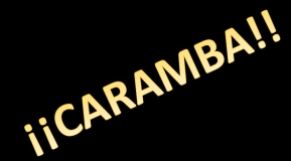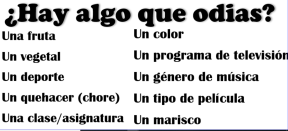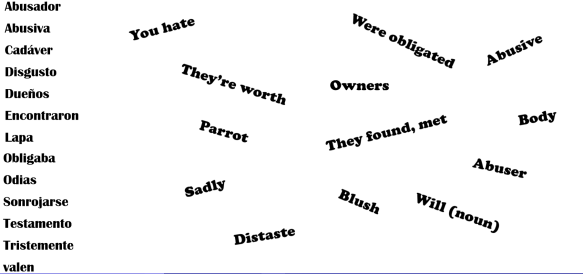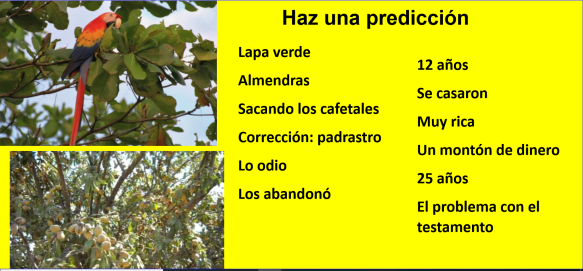Last year I used the book Felipe Alou: Desde los valles a las montañas by Carol Gaab for the first time. I blogged about it here. However, I only covered the first 7 chapters in that post, and since I am now working with the book for the second year, I thought I would add a bit more to it.
Updates from the second year:
Chapter 5
I like to use the audio CD for variety. For this activity, the students do NOT have their books as they listen to the audio. They have this: Capítulo 5 Obstáculos to complete during listening. This takes them to page 24, stopping where “Felipe esperó y esperó. ” Once they had listened, they had 2 minutes with their books to go back through and read to verify their answers. The map can be used through the end of the chapter and into chapter 6.
Based on Carrie Toth’s explanation of Quiplash from Wooly Week, I made a similar activity for chapter 4 and halfway through chapter 5 (chapter 5 is a very long chapter and I divided it into two parts). In my adapted version, the sentences being used may be actual quotes from the characters, quotes that they could have said, or just descriptive sentences. I chose Felipe, los entrenadores, las personas negras, las personas blancas, José/padre and el taxista as my characters. I ran 6 sets on card stock and divided my classes into groups of 4 – 6 students. Each student had at least one character. As I read the sentence or quote, they had to determine the character and rush to stand on their spot with the appropriate answer. Quiplash after 4 and halfway through 5
Last year I wrote about a timeline activity to set the stage for what was happening in the United States when Felipe arrived in 1956. It included events prior to 1950, during the decade of the 50’s and after 1960. Based on the work last year, I knew that it was really important to spend more time this year so that students have a better understanding of what Felipe encountered when he arrived. But, even more importantly, their own knowledge of our history is very minimal. This is definitely a cross curricular activity as my students struggled to identify even when Martin Luther King gave his most famous speech, or was assassinated, when desegregation happened and how slowly it happened, and even, most appallingly, when the Second World War occurred as opposed to the Korean War or Vietnam!
Chapter 6
Based on the original idea from Carrie Toth, I adapted “La Idea Central” (from Vida y Muerte en la MS 13) for Felipe Alou. Chap 6 La Idea Central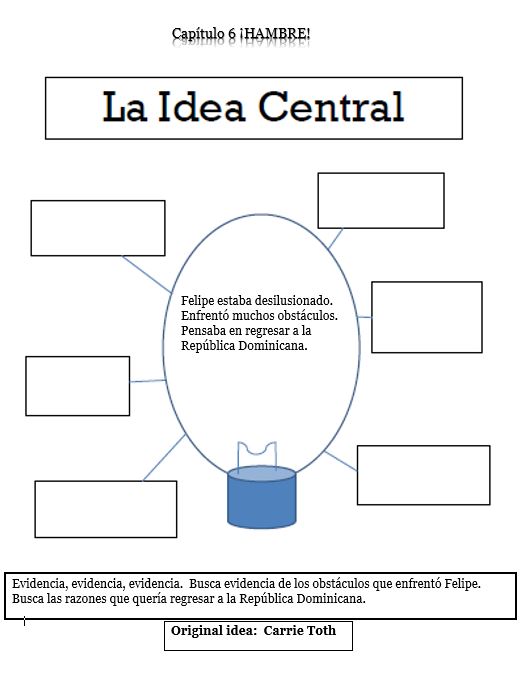
Chapter 7
Quizz Quizz Change: The activity where each student has a question card with the answer on the back. All students are up, find a partner, ask the question, listen to the answer (or help with the answer) and exchange cards with the partner before moving to another partner. This can be done with students wandering around (in a class that can handle that) or with inner/outer circle (for classes that need more structure). I ran the question/answers on cardstock, folded them in half and taped them. Quizz Quizz Change
Chapter 8
My partner in planning (Megan Matthews) adapted the Picasso Plates idea which was originally described by Kristy Placido or Cynthia Hitz (HELP!?). We ran off the restaurant scene from this chapter. Each student received a paper to place on his/her head (or do with eyes closed). The directions, script and restaurant scene are: escena del restauranterestaurant scene directions and script
Adapting again from Cynthia Hitz, here is the marker game PLUS for chapter 8. Marker Game Plus for chap 8
Sometimes, some repetitive practice combined with a familiar game is a good idea. Here is a link to a classtools.net database for chapter 8. I had the students play PacMan with this, although Wordshoot is also a good option.
Chapter 9
Word Sort: Use these words to have students begin to think about chapter 9. Student in groups of 2- 3, each group has a baggie with the words. Each group sorts the words into X number of categories. Students can make predictions for what they think will happen. Word Sort to open chap 9
Dustin Williamson shared a sound effects activity for this chapter that my students really enjoyed. I added one sound effect for jonron. 
Years ago, and I do mean years ago, I saved a powerpoint game template called CARAMBA! from someone, somewhere. I regret that I do not know to whom to attribute it, but it has been a well played game for many years! It is a game of both knowledge and chance…..and it always delights some students and makes others upset! I can’t upload the file here, but I am willing to share.
Chapter 10
Conversation Circles end of book is another idea from Carrie Toth that I again adapted from Vida y Muerte en la MS 13. 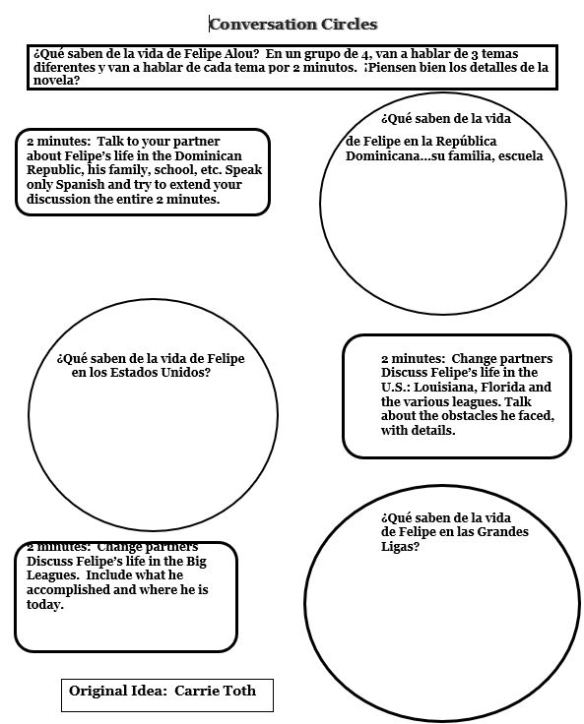
Need to focus on numbers? Here is a good review of numbers and info/stats from chapters 9 and 10. іNúmeros! chap 9 and 10
Slam It! Students are in groups of two (or three, if necessary). Read or project a statement/question. Each student writes the answer as quickly as possible and SLAMS his paper down on his desk (key to the fun!). If the student is correct when the answer is uncovered or stated, he scores a point. If incorrect, the partner scores the point. 
Chapter 11
Chapter 11 is a longer chapter. I wanted to divide it into sections and keep the students actively involved while we were reading it (example below). So I created 3 sections with three different games. Capítulo 11 during reading 
A culminating activity to summarize the “highs” (montañas) and the “lows” (valles) de Felipe. 
I hope there is something that you may find useful. I also would love to see what you are using/creating. Felipe Alou is one of my favorite books to teach!
Disclaiming again: I’m not a native speaker. I’m sure there are errors. Please correct as necessary.


